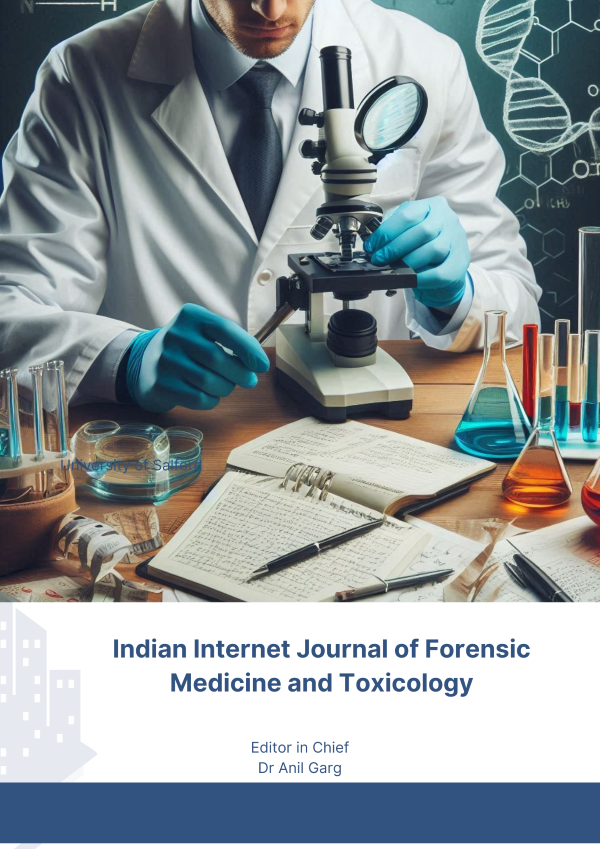An Epidemiological Burns Autopsy Study Along with its Source and Severity in a Tertiary Care Hospital
Keywords:
Burns, Epidemiology, Injuries, Flames, Electrical, AutopsyAbstract
Burns have always been considered as one of the most destructive injuries, causing not only deaths but also major economic and psychological impacts. This study has been taken up to characterize the epidemiology and to know the trend of the changing profile of the burn deaths. Materials and Methods: A total of 50 cases of death due to fatal burn injuries, which were brought to the mortuary of BPS GMCW, Khanpur Kalan, Sonipat, Haryana, India, between January 2013 and December 2015, were taken up for the study. Results: In the present, study of young women in age category of 21–30 years living in rural areas was commonly involved. Maximum number of victims were married and were housewives. Flames were most common physical agent for burn injuries in 74% of cases, whereas electrical injuries were seen in 26% cases. Maximum number of cases occurred during night-time (46%) especially around 7–8 PM or early morning. Most common manner of deaths was accident.
Downloads
References
[1] Afiffy MM, Mahmoud NF, Abd El Azzim GM, El Desouky NA. Fatal burn injuries: A five year retrospective autopsy study in Cairo city, Egypt. Egyptian Journal of Forensic Sciences 2012; 2:117-22.
[2] Burns. World Health Organization. World Health Organization; [Acessed2021Jul13]. Available from: http:// www.who.int/news-room/factsheets/detail/burns.
[3] Peck MD. Epidemiology of burns throughout the world. Part I: Distribution and risk factors. Burns 2011; 37:1087- 100.
[4] Bhansali CA, Gandhi G, Sahastrabudhe P, Panse N. Epidemiological study of burn injuries and its mortality risk factors in a tertiary care hospital. Indian Journal of Burns 2017; 25:62-6.
[5] Gadge SJ, Meshram RD, Shrigiriwar MB, Kuchewar SV. Epidemiological Study of Fatal Burn Cases in SVN Government Medical College. Journal of Academia and Industrial Research 2014; 2(10):552-5.
[6] Jaiswal AK, Aggarwal H, Solanki P, Lubana PS, Mathur RK, Odiya S. Epidemiological and socio-cultural study of burn patients in M. Y. Hospital, Indore, India. Indian Journal of Plastic Surgery 2007; 40(2):158-63.
[7] Kumar S, Verma AK. Audit of burn deaths among older adults in North India – An autopsy-based study. Egyptian Journal of Forensic Sciences 2016; 6(2):1-6.
[8] Navarrete N, Rodriguez N. Epidemiologic characteristics of death by burn injury from 2000 to 2009 in Colombia, South America: a population-based study. Burns Trauma 2016; 4(8):1-8.
[9] Sharma BR, Harish D, Sharma A, Sharma S, Singh H. Accidental burns in Indian kitchens: Are they really
accidental? Journal of Indian Academy of Forensic Medicine 2006; 28(1):14-7.
[10] Ambade VN, Godbole HV. Study of burn deaths in Nagpur, Central India. Burns 2006; 32:902-8.
[11] Batra AK. Burn mortality: recent trends and sociocultural determinants in rural India. Burns 2003; 29:270–5.
[12] Batra AK. Burn mortality: recent trends and sociocultural determinants in rural India. Burns 2003; 29:270–5.
[13] Zanjad NP, Godbole HV. Study of Fatal Burn Cases in Medico- Legal Autopsies. Journal of Indian Academy of Forensic Medicine 2007; 29(3):42-9.
[14] Singh D, Singh A, Sharma AK, Sodhi L. Burn mortality in Chandigarh zone: 25 years autopsy experience from a tertiary care hospital in India. Burns 1998; 24:150-6.
[15] Chawla R, Chanana A, Rai H, Aggrawal AD, Singh H, Sharma G. A two years burns fatality study. Journal of Indian Academy of Forensic Medicine 2010; 32(4):292-7.
[16] Saleh S, Gadalla S, Fortney JA, Rogers SM, Potts DM. Accidental burn deaths to Egyptian women of reproductive age. Burns 1986; 12:241-5.
[17] Nikerk AV, Laubscher R, Laflamme L. Demographic and circumstantial accounts of burn mortality in Cape Town, South Africa, 2001-2004: An observational register based study. BioMed Central 2009; 9:374-84.
[18] Koulapur VV, Yoganarsimha K, Gouda H, Mugadlimath AB, Vijay Kumar AG. Analysis of fatal burns cases–A 5 year study at Sri BM Patil Medical College, Bijapur, Karnataka. Medicolegal Update 2011; 11(2):107-9.
[19] Jayant D Deshpande, Padmakar K Baviskar, Deepak B Phalke. Epidemiological study of hospitalized burn patients in rural area. International Journal of Biomedical and Advanced Research 2012; 3(4):263-7.
[20] Dasari H, Kaur C, Kumar A. A comprehensive analysis of deaths due to burns in a tertiary care centre Journal of Punjab Academy of Forensic Medicine and Toxicology 2013; 13(2):68-73.
[21] Vidate S, Pathak H. Epidemiological Study of Thermal Burn Deaths at a Tertiary Care Centre in Mumbai, India. International Journal of Medical Toxicology and Forensic Medicine 2017; 7(2):117-23.

